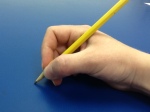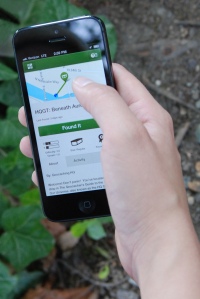Gallery
Many children we see at the clinic have difficulty assuming and maintaining a functional pencil grasp, which impacts their ability to write. What do we mean by “a functional pencil grasp”? Here are a few grasp patterns that we encourage:
Tripod Grasp – this is often seen as the “gold standard” for pencil grasp, however it is not the only  functional and efficient way to hold a pencil. The pencil is held between the thumb and index finger and rests on the side of the middle finger. The ring and pinkie fingers are tucked into the palm while the shaft of the pencil rests in the open webspace formed by the thumb and index fingers. This pattern requires strong intrinsic hand muscles and good stability at the joints.
functional and efficient way to hold a pencil. The pencil is held between the thumb and index finger and rests on the side of the middle finger. The ring and pinkie fingers are tucked into the palm while the shaft of the pencil rests in the open webspace formed by the thumb and index fingers. This pattern requires strong intrinsic hand muscles and good stability at the joints.
Quadrupod Grasp – this pattern is closely related to the tripod grasp, however, the pencil is held by the thumb,  index and middle finger and it rests on the side of the ring finger. The pinkie is tucked into the palm and the pencil shaft rests in the open webspace just like a tripod grasp. This pattern provides slightly more stability but does not sacrifice control or joint positions.
index and middle finger and it rests on the side of the ring finger. The pinkie is tucked into the palm and the pencil shaft rests in the open webspace just like a tripod grasp. This pattern provides slightly more stability but does not sacrifice control or joint positions.
Modified Tripod Grasp – Although this pattern looks quite a bit different than a standard  tripod grasp pattern, the pencil is held the same way by the tips of the thumb and index finger. The difference is that the shaft of the pencil rests between the index and middle fingers. This pattern may be beneficial for children who lack stability of their webspace and arches of the hand. The movement of the pencil remains unimpeded and the joint positions are ergonomically correct.
tripod grasp pattern, the pencil is held the same way by the tips of the thumb and index finger. The difference is that the shaft of the pencil rests between the index and middle fingers. This pattern may be beneficial for children who lack stability of their webspace and arches of the hand. The movement of the pencil remains unimpeded and the joint positions are ergonomically correct.
Chances are if you are reading this article, your child does not use one of the patterns listed above. Some children tuck their thumbs under their index fingers, which is referred to as a thumb tuck.

Others place their thumb on top of their index fingers for added stability, which is referred to as a thumb wrap.

Then there are a wide variety of other dysfunctional grasp patterns like this one:

Perhaps a teacher or other professional has suggested the use of a pencil grip but with so many different grips available, how do you know which one is right for your child? Speak with your occupational therapist to investigate the need for a grip. Here are some of the common grips available. Click on the pictures below for a larger image.
-

-
GROTTO GRIP — GOAL: Promotes a tripod grasp pattern and helps prevent incorrect thumb placement PROS: Easy to place the fingers correctly on the grip; Can also be used by a child with a quadrupod grasp pattern; Blocks thumb wrap and thumb tuck ; Promotes an open webspace and supports the arches of the hand; Used by righties and lefties without changing the orientation of the grip CONS: It is rather large and children who are reluctant to stand out in the classroom may not accept the grip; Relatively costly at about $2 each
-

-
STETRO GRIP — GOAL: Promotes a tripod grasp pattern without adding bulk to the pencil; PROS: Small and inconspicuous, therefore it may be accepted by older children who do not want to use a “therapy tool” in the classroom; Inexpensive at about $0.25 each CONS: Does not prevent thumb wrap or thumb tuck; Can be confusing to place fingers correctly – arrow on grip points down for righties and up for lefties, thumb is placed on the star
-

-
THE PENCIL GRIP — GOAL: Supports an ergonomically correct grasp pattern; PROS: Soft, comfortable material; Wider at the top to promote an open webspace; Can work for children who prefer a quadrupod grasp; Available in many colors, including glitter, which may act as a motivator for use; CONS: Does not prevent thumb wrap or tuck; Fingers can be placed incorrectly; Material is hard to clean; Relatively costly – about $2 each
-

-
TRIANGLE GRIP — GOAL: Creates a broader shaft of the pencil and encourages a functional pattern in an unobtrusive manner; PROS: Easy to place on the pencil, since the uniform shape has no appropriate up vs. down and fingers can be placed on any of the sides; Supports an appropriate grasp pattern without extra features a child with a mild grasp issue does not need; Inexpensive at about $0.25 each; CONS: Does not prevent thumb wrap, thumb tuck or other less functional patterns
-

-
CUSHION GRIP — GOAL: Decreases pressure on joints; PROS: Can help alleviate pain for children who grasp their pencil too tightly; Inexpensive at about $0.20 each; CONS: Does not actively assist with finger placement or prevent less functional patterns; Does not “fix” the problem of holding the pencil with excessive force
-

-
PENCIL WEIGHTS — Although pencil weights are not actually an adaptive grip, they can be useful for children with decreased body awareness or mild hand tremors GOAL: Increase stability of the pencil; PROS: Improves awareness of the movement of the hand; Offers stability for mild hand tremors; CONS: May lead to fatigue in children with poor hand strength; O-rings may be a choking hazard to younger siblings
A Word of Caution Regarding Any Pencil Grips:
- Whenever exploring the potential use of a pencil grip, the following must be considered:
- Does the grip support participation in handwriting tasks or does it cause more of a distraction?
- Can the child consistently place their fingers correctly on the grip or do they need assistance each time they pick up the pencil?
- Is the child willing to use the grip or will they hide it in their desk or “lose” it?
- Is the child working to develop the intrinsic musculature of the hand in order to transition away from needing a grip?
- What are the other factors impacting their writing? How is their trunk control? Are the seat and desk heights appropriately matched for the child? How is their proximal stability at their shoulder? What is their wrist position? Does the child efficiently separate movement between the two sides of the hand? How do their visual perceptual skills impact their writing? How does their regulation impact their attention and ability to sit long enough to master grip and graphomotor skills?
- Before a child enters Kindergarten, there is little need to use pencils or grips. Encourage the use of short crayons or pieces of chalk instead. A child’s grasp patterns continue to develop into a “mature” pattern around the age of 5-6 years old, so it is not uncommon to see a child alternate between functional and less functional grasp patterns up until this time.
![]()

























Written
on October 3, 2013